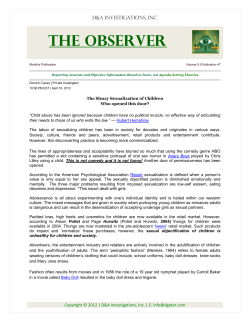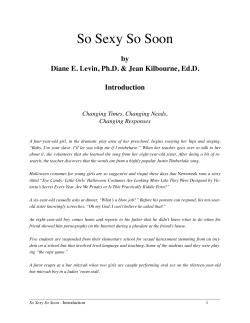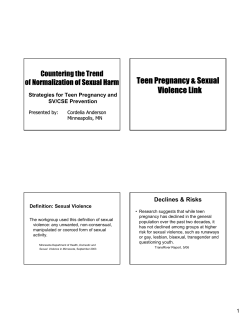
Facilitation Guide
Facilitation Guide The Film CONTEXT AND OBJECTIVES Documentary film by Sophie Bissonnette. Production: Patricia Bergeron and Yves Bisaillon (NFB) Canada – 2007 – 35 min. 24 s. This facilitation guide accompanies the documentary Sexy Inc. Our Children under Influence. Its goal is to sensitize viewers to both the issue of hypersexualization and its effects on young people. The guide has been developed to encourage discussion, share ideas and identify actions that will counter this phenomenon. Are children being pushed prematurely into adulthood? Sexy Inc. Our Children Under Influence analyzes the worrying phenomenon of the hypersexualization of our environment and its noxious effects on young people. In Sophie Bissonnette’s documentary, psychologists, teachers and school nurses speak out and criticize the unhealthy culture surrounding our children. With a wealth of examples from music videos, ads, fashion and TV shows, this medium-length film gets to the nub of the problem. Marketing and advertising are targeting younger and younger audiences and bombarding them with sexual images. Sexy Inc. shows how girls are being represented in a sexualized and sexist way, reducing children to mere consumers and conveying dispiriting stereotypes. From a very young age, girls are treated as sexual objects, their development is not respected, and the lines between childhood and adulthood are blurred. Sexy Inc. offers adults various ways to counter the cynical exploitation of sexuality and the proliferation of sexist images. Produced as part of the project “Countering Youth Hypersexualization: Tools for Prevention and Action”, the film is an invitation to us all to rally and do our bit to mitigate an extraordinarily unhealthy situation. The facilitation guide can be used with different groups who are likely to have an interest in this powerful documentary: > Educational personnel: elementary and high school teachers > > > > as well as college and university professors; Professionals working in the areas of social services and health care, as well as community and affiliated organizations; Parents; Young adults; Citizens who are interested in the subject or concerned with youth issues. This guide can be used in various facilitation contexts: parent meetings, gatherings of educational personnel, awareness activities, educational workshops, conferences, public forums, etc. We suggest a post-film exchange with the viewing audience of about one hour. Keep in mind that Sexy Inc. is intended for adult viewing. The film content includes references to pornography as well as sexually explicit information and images which are inappropriate for those under 15 years of age. It is not recommended to show the film to children or adolescents. The accompanying facilitation guide has not been conceived for use with a young audience. HOW TO USE THIS GUIDE This facilitation tool has been developed along a three-fold pedagogical approach based on the observation, analysis and transformation of reality. Taking a closer look at your environment This first step in the facilitation process is aimed at encouraging the viewers to begin to identify how hypersexualization manifests itself in their environment and to establish a link between the film’s subject and their daily lives. Questioning hypersexualization The second step aims to lead the viewers towards a deeper analysis of the phenomenon: its manifestations, the industries that generate the phenomenon, the economic and social issues which arise, and its toxic effect on young people, especially girls. This analysis leads viewers to identify the actors in this global phenomenon in order to better understand it and deal with its consequences. Identifying strategies To transform reality, we must first reflect on our attitudes and behaviour. Before setting out to “change the world”, the viewers are encouraged to think about their own actions. For example: As a teacher, what do I think about the hypersexualization of the students in my school? As a parent, should I bring up the subject with my child or my teenager? As a youth worker, what is my reaction to this phenomenon? Now that I am aware of the extent and toxic impact of hypersexualization, what can I do to counter it in my environment? Concrete actions can emerge from the dialogue between the viewers, and the facilitation should aim to encourage these initiatives. Preparing to facilitate > View the film before facilitating a discussion with an audience. > Get to know the definitions of sexualization proposed in the guide to better understand the phenomenon. > Study the questions proposed in the next section and adapt them to the particular needs of your audience. > Consult the resources provided at the end of this guide. They could be useful if you are asked for additional information on this subject. > Don’t forget that you are there to encourage dialogue between the participants and to guide the group, not to act as an expert on the subject. In this regard, the facilitation guide offers several suggestions that will allow you to enhance the discussion if needed. DEFINITIONS OF SEXUALIZATION “The act of giving a sexual characteristic to a product or behaviour which is not intrinsic to it.” - Free translation, Bouchard & Bouchard, 2004. In 2007, the American Psychological Association (APA) published a report on sexualization and its impact on young people. The Association explained the phenomenon in the following way: “There are several components to sexualization, and these set it apart from healthy sexuality. Sexualization occurs when: o A person’s value comes only from his or her sexual appeal or behaviour, to the exclusion of other characteristics; o A person is held to a standard that equates physical attractiveness (narrowly defined) with being sexy; o A person is sexually objectified — that is, made into a thing for others’ sexual use, rather than seen as a person with the capacity for independent action and decision making; and/or o Sexuality is inappropriately imposed upon a person. All four conditions need not be present; any one is an indication of sexualization. The fourth condition (the inappropriate imposition of sexuality) is especially relevant to children. Anyone (girls, boys, men, and women) can be sexualized. But when children are imbued with adult sexuality, it is often imposed upon them rather than chosen by them. Self-motivated sexual exploration, on the other hand, is not sexualization by our definition, nor is age-appropriate exposure to information about sexuality.” American Psychological Association (2007). Report of the APA Task Force on the Sexualization of Girls, Executive Summary, p.1. Facilitation [ Before girls needed to be pretty and nice, now they have to be pretty and hot. TAKING A CLOSER LOOK AT YOUR ENVIRONMENT QUESTIONING HYPERSEXUALIZATION > What is your spontaneous reaction to this film? > Is the phenomenon of hypersexualization present in your > Hypersexualization in our environment involves many issues environment (family, school, workplace or organization)? > How has this phenomenon manifested itself in your environment? For example, do you recognize it in the dress, attitudes or behaviour of the young people in your life? > Based on the definitions offered in this guide as well as those portrayed in the film, would you say that sexualization is a new or an old phenomenon? Do you think that the sexualization of children is a relatively new occurrence in your environment? whether economic, social or psychological. The film Sexy inc. presents some of the issues that are of concern to parents, community workers, educational personnel and young people themselves. Can you identify them? > In the film, it is stated that pornography is everywhere and pornographic codes have infiltrated all areas of our lives. What do you think about this statement? To what extent has the public space been sexualized, in your opinion? We have replaced religion and spirituality by the Gods of consumption. From an economic and political standpoint Pornography is now everywhere and its codes have infiltrated all the domains of our lives. > Who is promoting the sexualization of children and adolescents? Who profits from this phenomenon? > The film suggests that children, especially girls, are the targets of marketing specialists who sell them age inappropriate products so they will become lifetime customers. What do you think about this economic strategy? > Should we create laws to limit or ban the use of children in advertising or the use of sex to sell merchandise, especially to minors? How can we go about it? QUESTIONING HYPERSEXUALIZATION QUESTIONING HYPERSEXUALIZATION From the standpoint of equality between women and men From the standpoint of psychosocial development > The film shows how the hypersexualization of public space relies > In the film, an elementary school principal remarks that we are > Are some young people more vulnerable to hypersexualization > Is hypersexualization blurring the line between childhood on and reinforces well established sexual stereotypes. How can we explain the strong comeback of sexual stereotypes? What impact does this have on girls and on boys? Is the impact different according to gender? and by consequence more susceptible to identifying with these sexist and sexualized models? What needs are these girls and boys fulfilling by identifying with these stereotypes? stealing childhood from children by pushing them to become “little adults” and by making them experience emotions that are difficult to deal with at their young age. What do you think about this statement? and adulthood? What might be the consequences of this phenomenon as it impacts the psychological development of children and teenagers? > In your opinion, are we more worried about the impact on girls rather than on boys? If yes, what explains our greater concern about the impact on girls? If no, why are we not more concerned? The more girls consume sexualized images, the more they risk suffering poor self-esteem, depression and even eating disorders. IDENTIFYING STRATEGIES >You are a parent or a youth worker. Do you think it is necessary to initiate discussion or educational activities with young people on the subject of hypersexualization? How would you approach the subject with them? What values would you hope to communicate through these exchanges? >A specialist appearing in the film showed how when searching the word “pussy” on the Internet, children have access to more that one hundred pages of Internet sites. Most of these sites would be characterized as pornographic. Do you think that in your professional or family environment, young people have easy access to these images whether they’re searching for them or not? Should we intervene in order to limit youth access to these sites? Is limiting or forbidding access the only strategy to undertake? >The film presents many strategies for action. Some of you may have already taken a firm stand against hypersexualization. Would you like to share it with the group? >What targeted action or actions should be taken collectively to combat these phenomena? >Should the government intervene to counter hypersexualization and its effects on young people? If yes, what government authority or authorities should be called upon? What actions should be undertaken? >Should the marketing industry be obliged to adopt a code of ethics whose goal is to counter hypersexualization? If yes, what should be included in this code of ethics? 10 Strategies The best solution is to develop girls’ critical skills so they can decode the environment in which they live. » Strategies for teachers and professionals working with youth » Strategies for parents » Help young people develop critical thinking skills by giving » Think about the values and the messages that you want to convey them the opportunity to question and reflect on the significance of different messages circulated by the media and the fashion and advertising industries. » Guide young people towards Internet Sites which present positive images of sexuality and sexual equality, for example: ‹www.sexualityandu.ca›, ‹www.youngandhealthy.ca› and ‹www.scarleteen.com›. » Respond as honestly as possible to the questions asked by young to your children, both to your sons and your daughters. » State your position, negotiate limits, affirm your values and have them respected. » Respond as honestly as possible to your children’s questions about sexuality, while respecting their age and maturity as well as their level of sensitivity. » Encourage your children to distance themselves from what’s in people concerning sexuality, always respecting their age and maturity as well as their level of sensitivity. fashion, hypersexualized culture and peer groups who are involved in this culture. » Use aspects of their world in the course of an activity (music » Help your children to assert themselves and to recognize who they videos, song lyrics, television shows, etc.) to help them reflect on sexual stereotypes, relationships, violence, etc. » Organize discussions and debates with young people on themes that deal with hypersexualization, advertising images of men and women, Internet porn, violent lyrics in popular music, etc. » Be a positive role model for young people in your attitudes and behaviour. » Work in partnership with parents, schools and the community so that a consistent message is conveyed and that appropriate actions are taken. are, based on their values, their strengths and also their limitations. Understand the pressure they might be under. » Value your daughters more for their personal achievements than for their physical appearance. Value your sons more for their personal achievements than for their performance. » Discuss with your children your parental concerns about hypersexualization. Don’t be afraid to take a stand and to be consistent with your principles. » Be a positive role model for your children in how you relate to others. » Share your fears and experiences with other parents. Don’t isolate yourself. 12 13 » Strategies for young adults »S trategies for citizens » Interest yourself in the issue of hypersexualization and its » Make your opposition known to companies that circulate sexist consequences; for example its impact on the equality between men and women. » Learn more about this phenomenon as a part of your academic studies and sensitize your peers by sharing the results of what you’ve learned. » Be a responsible consumer by being critical and even selective about what music you listen to, what you watch on television, what you read and what you buy. » Be a role model for youth by conducting your sexual and love relationships with dignity and respect. » Be a positive role model for your siblings in your dress, attitude, and behaviour and by showing them how to be a responsible consumer. 14 or degrading messages or who use the bodies of children or adolescents to sell their merchandise. » Give your opinion, write articles, and participate in blogs that talk about the subject of early sexualization, sexual stereotypes or hypersexualization. » Complain about organizations who contribute to the sexualization of public space and the reinforcement of sexual stereotypes. » Be a responsible consumer by not buying products which use sex or sexual stereotypes to sell. » Be aware of events organized on the subject and see how you, as a citizen, can contribute. » Share with your circle of friends, family and colleagues what you are doing to counter this phenomenon and encourage them to do their part. 15 SUGGESTED RESSOURCES ‹www.sexualityandu.ca› This site is dedicated to the dissemination of accurate information and timely news about health and sexuality. It is an educational and interactive site that has informative sections addressed to parents, teenagers, teachers and health professionals. The site also offers advice and intervention strategies. AMERICAN PSYCHOLOGICAL ASSOCIATION (2007). Report of the APA Task Force on the Sexualization of Girls. Washington, DC: American Psychological Association. Retrieved from ‹www.apa.org/pi/wpo/sexualization.html›. GOUVERNEMENT DU QUÉBEC (2007). Transformations, Butterflies, Passions… and All Sorts of Questions: Parents’ guide for discussing sexuality with their teens. Direction des communications du ministère de la Santé et des Services sociaux, 43 p. Retrieved from ‹www.msss.gouv.qc.ca/itss› by clicking English, Documentation and then Parents. KILBOURNE, Jean (2000). Can’t Buy My Love: How Advertising Changes the Way We Think and Feel. New York: Touchstone Editions. LAMB, Sharon & Lyn Mikel BROWN (2006). Packaging Girlhood. Rescuing Our Daughters from Marketers’ Schemes. New York: St. Martin’s Press. QUART, Alissa (2003). Branded: The Buying and Selling of Teenagers. New York: Basic Books. SCHOR, Juliet (2004). Born to Buy. New York: Scribner. ‹www.media-awareness.ca› This site from the Media Awareness Network offers a wide array of resources for parents and educators to help develop critical thinking skills in young people to help them understand the messages they receive from the media. It provides documentation, advice and activity suggestions to help adults talk to young people about the media, and advice on managing media use in the home and at school. How can we help our children become informed internet users? This site provides information, practical tools and much more! INTERNET SITES ‹www.ydesfemmesmtl.org› The website of the Montreal YWCA, which before its involvement in this film had produced in 2006: Early Sexualization: A guide for parents of preteen girls. The animated version can be viewed online or the PDF version retrieved from the English side of the site: Leadership and Empowerment tab, Early Sexualization section. ‹www.hypersexualisationdesjeunes.uqam.ca› This site’s information is currently available only in French. “Countering Youth Hypersexualization: Tools for Prevention and Action” is a project whose aim is to sensitize young people and the adults in their life to the hypersexualization and early sexualization phenomena. The project includes training for professionals in the fields of education, health, social services and in community and affiliated organizations. 16 ‹www.mediarelate.org› “MediaRelate” is a project that has produced and is evaluating teaching materials about the media, sex and relationships in the media, for use in school classrooms and non-formal settings with young people aged between twelve and fifteen. ‹www.powercampnational.ca› POWER Camp National is a charitable organization which through a national network of organizations supports the empowerment, leadership and healthy development of girls and young women across Canada. Their programs tackle the themes of violence prevention, community engagement, art education, antiracism and the promotion of general health and sexuality. POWER Camp National believes that each girl should have what she needs to fully participate in society and through local programs for girls and young women allows each girl to develop her abilities, discover her power and gain the confidence she needs to share her gifts with the world. ‹www.youngandhealthy.ca› This site is a production of the Canadian Association for Adolescent Health (CAAH). The website brings together healthcare professionals from different backgrounds such as physical and mental health, public health, social services, education, and research and community action. The site offers young people accurate information to help them make good choices in regards to their sexuality and maintaining good health. ‹www.campaignforrealbeauty.ca› Unilever is the corporation behind the Dove brand’s “Campaign for Real Beauty”. This site is an initiative aimed at sensitizing girls to the importance of being comfortable with their own bodies and to overcoming the pressures of the media and the beauty industry. Other resources are also available for parents and educators. The site offers video clips which cast a critical eye on the beauty industry. An interesting example of corporate responsibility! 17 This facilitation guide is a production of the project “Countering Youth Hypersexualization: Tools for Prevention and Action”. Conception: Geneviève Gagnon and Irène Demczuk Revision: Lilia Goldfarb and Emily Keenlyside Translation: Susan Dwire Graphic Design: www.lamamzelle.com This guide was made possible thanks to the financial participation of Forum Jeunesse de l’île de Montréal. A film by Sophie Bissonnette Produced by Patricia Bergeron and Yves Bisaillon (NFB) FOR MORE INFORMATION | 1-800-267-7710 | ‹www.nfb.ca› © 2007 National Film Board of Canada. Printed in Canada.
© Copyright 2025

















